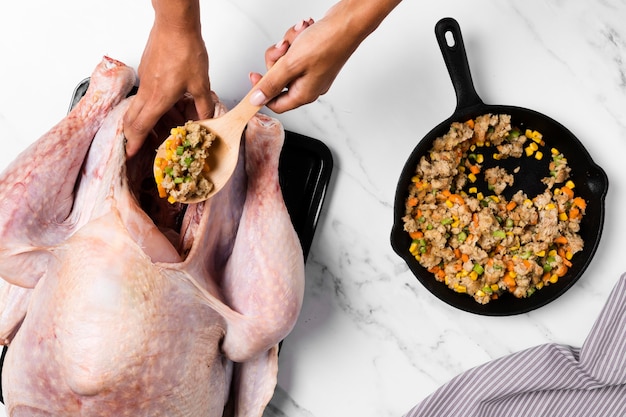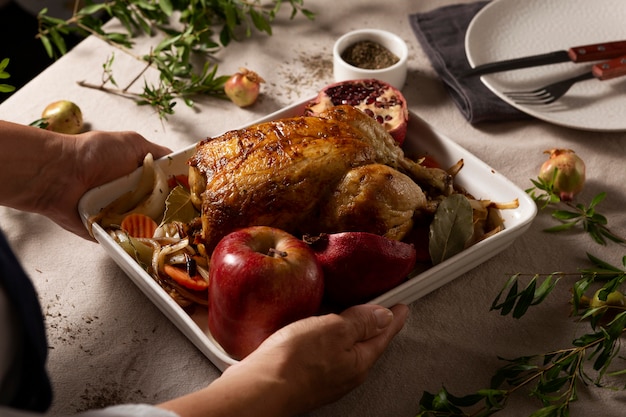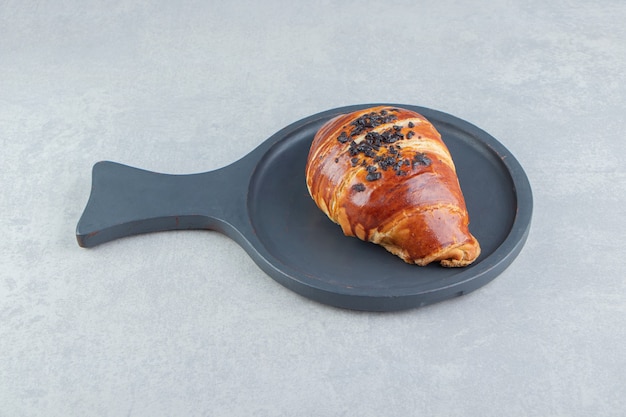You've got a beautiful piece of Round Top Roast, a cut of meat brimming with flavor and potential. But let's face it, tackling a roast can seem intimidating, especially for the novice cook. Don't worry! I'm here to guide you through the process, sharing my years of culinary adventures and tips for achieving roast perfection. Grab a mug of your favorite beverage, settle in, and let's dive into the world of Round Top Roast together.
(Part 1) Selecting the Perfect Cut

Choosing Your Weapon: Round Top Roast
First, we need to choose our star ingredient. I'm a huge fan of Round Top Roast, a lean cut full of deliciousness. Its beautiful marbling adds richness and depth to the flavor, and it's generally a budget-friendly option. You can easily find Round Top Roast at most supermarkets, making it a readily available choice.
Finding a Good One: What to Look For
When you're browsing the meat selection, take a moment to examine the Round Top Roasts. Look for a vibrant, deep red color, a good amount of marbling throughout, and avoid anything that seems pale or dry. A cut with excessive fat might be too greasy, so aim for a balance of lean meat and marbling for optimal results.
(Part 2) Preparing the Roast

The Art of Seasoning
Now, your Round Top Roast is ready, and it's time to unleash its flavors. I like to keep things simple, focusing on the classic salt, pepper, and herbs. Rosemary, thyme, and sage are always a winning combination. But don't be afraid to experiment! Garlic powder, onion powder, or your favorite spices can add an extra dimension of flavor. Just remember, a little goes a long way. You don't want to overwhelm the natural taste of the meat with too much seasoning.
A Little Rub-a-Dub-Dub
For an extra layer of flavor and to help the seasoning adhere to the meat, I often rub the roast with a touch of olive oil. It also helps prevent the roast from drying out during cooking. Any oil will do, but I always opt for olive oil for its distinct flavor.
(Part 3) cooking techniques

Roasting in the Oven: The Classic Approach
The most common and reliable way to cook Round Top Roast is in the oven. It's a simple, straightforward technique that consistently delivers delicious results.
The Temperature Game
The secret to oven roasting success lies in the temperature. A good rule of thumb is to cook your Round Top Roast at 180 degrees Celsius (350 degrees fahrenheit). To achieve a medium-rare doneness, aim for an internal temperature of 145 degrees Fahrenheit. You can use a meat thermometer for accuracy, or try my old trick: use a sharp knife to pierce the meat. If the juices run clear, it's done. If they run pink, it needs a bit more time.
The Time Factor
The cooking time depends on the size of your roast. Generally, plan on about 20 minutes per pound of meat. Remember, even cooking is crucial, so rotate the roast every 30 minutes or so to ensure it cooks evenly on all sides.
Sous Vide: A Modern Twist
If you're feeling adventurous, try cooking your Round Top Roast using the sous vide technique. Sous vide involves submerging the meat in a precisely temperature-controlled water bath, delivering incredibly consistent results.
The Water Bath
First, season your roast and seal it in a vacuum bag. Then, submerge the bag in a water bath set to 130 degrees Fahrenheit for medium-rare. You can invest in a sous vide machine, or even use a large pot and a thermometer.
The Finishing Touches
After cooking, remove the roast from the bag and give it a quick sear in a hot pan for a delicious, crispy crust.
(Part 4) Serving Suggestions
The Roast's Companions: Sides
Now that your Round Top Roast is perfectly cooked, it's time to consider the side dishes. Classic roast accompaniments like roast potatoes, Yorkshire pudding, and gravy are always a winning combination. But don't be afraid to get creative! Mashed sweet potatoes, green beans, or even a refreshing green salad can complement the roast beautifully.
The Importance of Gravy
No roast is truly complete without a hearty gravy. Don't be intimidated; it's much easier than you might think. Simply add some water or stock to the pan where the roast was cooked, scraping up all the tasty bits. Bring it to a boil and thicken it with flour or cornstarch. And there you have it, a delicious gravy to tie everything together.
(Part 5) Leftovers: A Second Chance at Deliciousness
The Art of Reheating
So, you have some leftover roast beef and you're wondering what to do with it. Don't even think about throwing it away! Leftover roast beef is a treasure trove of culinary possibilities.
Reheating Methods
You can reheat your roast in the oven, on the stovetop, or even in the microwave. Just be sure to keep a watchful eye to prevent it from drying out.
Leftover Magic
Once your roast is reheated, the world is your oyster! It's perfect for sandwiches, salads, hearty stews, cheesy pasta bakes, beef and broccoli stir-fries, and so much more.
(Part 6) Frequently Asked Questions
FAQs
- Can I cook a Round Top Roast from frozen? While not ideal, it's possible. Thaw the roast thoroughly in the refrigerator first. You might need to adjust the cooking time slightly to account for the extra moisture.
- What kind of oven should I use to cook a Round Top Roast? A traditional oven is perfect, but if you have a convection oven, you can use a slightly lower temperature.
- What's the best way to tell if my roast is done? A meat thermometer is the most reliable way to check doneness. Aim for an internal temperature of 145 degrees Fahrenheit for medium-rare.
- Can I use a different cut of meat? Absolutely! Just be aware that different cuts might require different cooking times and temperatures.
- What can I do with the leftover juices from the roast? The juices are pure gold! Use them to make gravy or to deglaze the pan after cooking the roast.
(Part 7) A Few Tips and Tricks
The Magic of Marinade
For an extra burst of flavor, consider marinating your Round Top Roast for a few hours before cooking. A marinade can tenderize the meat and infuse it with a deeper, richer flavor profile.
A Simple Marinade
Try combining olive oil, red wine vinegar, garlic, and your favorite herbs for a simple marinade. You can also add a touch of honey or brown sugar for sweetness.
Marination Tips
Always marinate the meat in the refrigerator and ensure it's completely submerged in the marinade.
The Secret to Tenderness
To ensure a wonderfully tender Round Top Roast, add a few slices of onion or carrot to the pan while it's cooking. These vegetables release moisture, helping to keep the meat juicy.
The perfect roast: A Visual Guide
Here's a table to guide you in achieving the perfect level of doneness for your Round Top Roast:
| Doneness | Internal Temperature (°F) | Color of Juices |
|---|---|---|
| Rare | 125-130 | Red |
| Medium-Rare | 130-140 | Pinkish-Red |
| Medium | 140-150 | Light Pink |
| Medium-Well | 150-160 | Pale Pink |
| Well-Done | 160 | Clear |
(Part 8) The Joy of Round Top Roast
There you have it, a comprehensive guide to Round Top Roast! This versatile cut can be transformed into culinary masterpieces through various cooking techniques. From the classic oven roast to the modern sous vide approach, there's a method for every palate.
So, next time you're seeking a delicious, satisfying meal, give Round Top Roast a try. It's a culinary adventure waiting to happen!
Remember, cooking is a journey of experimentation and joy. Don't be afraid to try new things and most importantly, savor the process. Happy cooking!
Everyone is watching

Corn on the Cob: The Ultimate Guide to Perfectly Cooked Ears
Healthy MealsAh, corn on the cob. Just the name evokes images of sunny days, barbecues, and that sweet, juicy flavour that ...

Perfect Pork Roast Oven Cooking Time: A Guide to Delicious Results
Healthy MealsThere's something truly satisfying about a perfectly roasted pork. The aroma alone is enough to make your mout...

Ham Cooking Time: How Long to Bake, Smoke, or Boil a Delicious Ham
Healthy MealsAh, ham. It's a classic, isn't it? A real crowd-pleaser, especially around holidays. And when done right, it'...

Scallops: The Ultimate Guide to Perfect Cooking
Healthy MealsAh, scallops. Those delicate, sweet, and utterly delicious morsels of the sea. They hold a special place in my...

Spaghetti Squash: The Ultimate Guide to Cooking and Serving
Healthy MealsRemember that time you saw spaghetti squash at the supermarket, looking all bumpy and strange, and thought, "W...
